|
TikiWiki Assistant Thank you for installing TikiWiki!
Click the :: options in the Menu for more options. Please, also see TikiMovies for more setup details. |
D.ctimeL1A
To link together the "times" measured with the Neutron Detector Electronics (relative to the L1A) and those measured with the BigBite electronics (relative to the BBtrig), it helps to understand the way the two trigger systems worked. A diagram of the coincidence-trigger layout can be found in GenDocTrigger. In all cases, the relative time difference between the two reference times (common signals) are recorded by the Lecroy 1875A TDC corresponding to the D.ctimeL1A[0] variable in the TTree.
0.05*D.ctimeL1A[0] (ns) = L1A - BBtrigTimes recorded in the neutron detector are relative to L1A, which means that: ND_recorded_time = ND_real_time - L1A.So to relate a time in the ND to something from BigBite, the "L1A" has to be replaced by "BBtrig", so one does:
ND_time_relative_BB = ND_real_time - BBtrig
= ND_real_time - L1A + (L1A - BBtrig)
= ND_recorded_time + (L1A - BBtrig)
ND_time_relative_BB = ND_recorded_time + 0.05*D.ctimeL1A[0]
Likewise, to get a BB time relative to the ND trigger to compare against some ND variable, just subtract 0.05*D.ctimeL1A[0].The NeutronDetector generated triggers using an energy sum over multiple modules; this trigger is designated as T1. The BigBite spectrometer generated its own trigger signal, called T2, from a threshold placed upon the energy deposited in its calorimeter. The T1 and T2 signals were then passed to a coincidence unit (see GenDocTrigger), such that a logical AND of the signals formed the coincidence trigger T3. The leading edge of T3 was determined by when the overlap of T1 and T2 occurred. The trigger supervisor would then form the L1A with a time relative to the accepted trigger. The ASCII figure below tries to demonstrate this for a normal "good" T3 event. A. Normal "good" event where T3 determined by T1 time, and L1A by T3
T1 ___________ _________________
| |
|________|
T2 ______ _________
| |
|_____________________|
T3 __________ ______________
| |
|___________|
L1A __________
|
|__________________________
Prior to the experiment, the relative timing of the T1 and T2 trigger signals into the discriminator were set such that T1 should come after T2, and so determine the time of the T3 and the L1A. The width of the T1 and T2 signals going into the coincidence unit 40-45ns for T1, and 95 to 100ns for T2 for kinematics 3 and 4 at least, with the T1 coming ~35ns after the T2. Events were collected with a mix of other relative-timings between T1, T2, T3, and the L1A. First, if T1 came "too early" (perhaps due to an accidental coincidence), then the timing diagram looks like this: B. T1 too early, so T3 and L1A determined by T2, and L1A by T3
T1 ________ __________________
| |
|________|
T2 __________ __
| |
|_____________________|
T3 __________ ____________
| |
|___________|
L1A __________
|
|________________________
where T3 and the L1A are timed exactly relative to T2. To generate BBtrig (noted in the trigger diagrams of GenDocTrigger as "L1A(retimed)"), the reference signal for the BigBite arm, a copy of T2 and the L1A are passed into a retiming module. The retiming module is supposed to generate a signal with a fixed-delay to T2, or if T2 is missing (normally the case for a T1 event) generate a signal with a fixed-delay with respect to the L1A. If the T2 came very early, it is possible for its leading edge to become lost such that BBtrig is aligned with the L1A; this can be checked by looking at the time distributions for detectors in BB (eg: B.s.time[B.s.trpad[0]) for this class of events. In this case, the trigger timing diagram could look like this:C. Forced retiming case: timing of BBtrig determined by L1A, NOT by T2
T1 ______________________ _____
| |
|________|
T2 __ ____________
| |
|_____________________|
T3 ______________________ __
| |
|___________|
L1A ______________________
|
|______________
T2d ___________ _
(delayed) | |
|________________|
BBtrig ____
|
|______________
All these effects together result in D.ctimeL1A and D.bit3 distributions that are shown in the following plot of D.ctimeL1A (y-axis) vs. D.bit3 (x-axis). Note that to get the correct "first" recorded T3 time from the 1877 TDC, you have to get the last readout value from the TDC so D.bit3[Ndata.D.bit3-1] must be used. Created by: feuerbac last modification: Tuesday 19 of December, 2006 [20:39:41 UTC] by feuerbac
wiki page:
GEn
· AsymmetryCorrections
· Livetime
· Kin4:Pass1
· GEnDocDiag
· D.ctimeL1A
· AdaqBackup
· Pass0
· Coordinate Systems
· GEnDocEpics
· Glossary
· GEnDocTrigger
· GEnDocMisc
· analyzer
· AGEn Library
· GEnDocChannelMap
· GEnSpecialEvents
·
article: GEn · GEn · Rob's Analysis · |
Login Search
|







